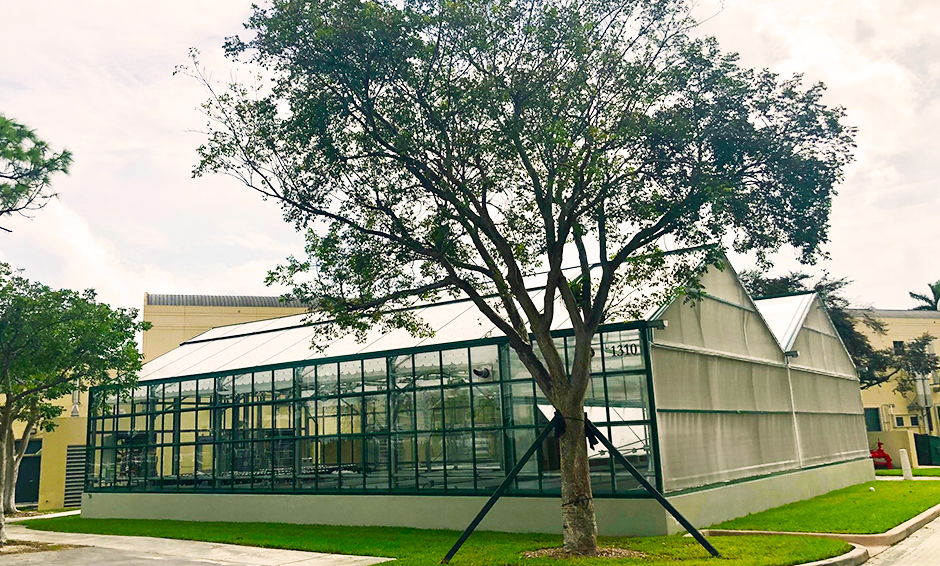When the new greenhouse at the University’s John C. Gifford Arboretum began operations this fall, no one was more excited than Michelle Afkhami, an assistant professor of biology.
“My research depends on being able to grow a large number of plants, so when I joined the UM faculty [in 2016], we discussed the need for a greenhouse,” said Afkhami. “It has since taken on a much bigger life, expanding to different modules with space for teaching, outreach, and research in collaboration with other parts of the university.”
“The greenhouse will improve our ability to conduct experiments and test hypotheses on topics such as plant adaptation to climate change and the role of animals in seed germination,” said Mauro Galetti, director of the arboretum and assistant professor of biology. “It ushers in a new era of research for our department.”
For Afkhami, the facility affords a newly spacious and research-friendly setup.
Her team’s research focuses on plants and microbiomes—the microbial communities found in leaves, roots, and tissues of plants. She previously had to make do with whatever nook and cranny was at hand to grow enough plants to keep going.
“I’ve had plants all over the Cox science building, including the basement,” Afkhami says with a laugh. “I had mangroves growing in one room, Florida scrubs natives in another, Pine Rocklands species in another. The university was kind enough to give me a walk-in grow room, but it just wasn’t enough space for all the projects.
“All my experiments to date have been in older lab spaces with racks of lights, which worked okay but really limited the accuracy of some conclusions. The new greenhouse will definitely improve the quality of my research.”
As currently configured, the greenhouse has two main research modules. Afkhami occupies the 1,500-square-foot space, outfitted with air conditioning. There is also a smaller 1,200-square-foot space, cooled by evaporative swamp coolers.
High-Tech, Low-Profile
“When you say ‘greenhouse,’ most people assume there’s not much to it beyond four walls and a roof,” says Ryan Coffield, Miami’s project manager for design and construction. “But its operation takes a lot of intricate, robust control systems.
“The greenhouse basically runs itself, thanks to its own programmable weather station,” Coffield explained. “It can move the canopy over areas to maintain the right amount of daylight, monitor wind speeds and humidity—whatever is needed to keep the settings consistent for the research underway.”
Getting the greenhouse built was a long, winding, years-long process. The original proposal called for it to be located at Fairchild Tropical Botanic Garden; when that arrangement fell through, Provost Dr. Jeffery Duerk and Arts and Sciences Dean Dr. Leonidas Bachas came to the rescue.
“Provost Duerk and Dean Bachas were very supportive,” said Professor Athula H. Wikramanayake, chair of the University’s Department of Biology, which manages the facility. “The greenhouse would not have happened without them.”
Steve Pearson, the former director of the arboretum, played a key role in obtaining support to build the greenhouse there. “It’s in a perfect place, almost right next to the science building, “ Pearson said. “Undergraduates can work there instead of having to drive somewhere five or six miles away.”
Construction started in the spring of 2020 and took a few months longer to complete than the six months originally projected, due in part to delays caused by the COVID-19 pandemic. But the greenhouse was up and running by the fall 2020 semester. For now, it is only open to faculty and students. When it becomes safe to reopen to the public, the greenhouse will be a focus of outreach efforts to local schools.
“There are not a lot of arboreta in the U.S. in subtropical areas,” said Wikramanayake. “Our arboretum and greenhouse can serve as a nursery for endangered tropical species, which we can grow right on campus. That’s an important benefit.”
Wikramanayake added that the facility was carefully designed to be aesthetically pleasing and to blend in well with the arboretum’s existing ambiance. The arboretum continues to be, in his words, “a peaceful, serene place for walking dogs and hanging out”—as well as a new locus of state-of-the-art botanical research.

